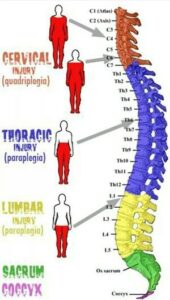Straight Talk about the Spine
Gloria Tucker MD, Diplomate of the American College of Sports Medicine
February 14, 2022
One of the most useful things I have in my office is a skeleton. Almost every day, I bring at least one of my patients in and show them the skeleton. I want them to see the normal curves of the spine. Our back and neck are not a straight vertical line. We are flexed backward (extended) in the neck, forward (flexed) in the chest, and backward (extended) in the low back.
Now consider the way we spend our days. Most of us spend a certain amount of time at a computer, on the phone or reading a book. How about when we go walking in the woods? Where is your neck (cervical spine)?

For most of us it is flexed downward. Just the opposite of our anatomical position. What does this mean? It means that we are stretching the ligaments on the back of the neck and tightening those in the front. And this results in PAIN in the upper neck.
In other cases, some people lead with their head when walking, so the transition area between the cervical (brown) and thoracic (purple) spine is extended rather than flexed. This means that the transition area, which should be in some flexion, is extended. What does this mean to the patient? PAIN in the lower neck.
Let’s talk about the mid back. Overall, it is in a flexed and extended position, flexed toward the top and extended toward the bottom. Most people work with their hands and arms in front of them. And when we slump in a chair, the extension of the lower thoracic region is lost, stretching the ligaments in the back of the body, and collapsing in the lower abdomen. It feels good for a few minutes and then we get fidgety with discomfort in our midback.
The cornerstone of the spine is the lumbosacral spine. This is the most important place for stability of the spine. In the diagram above, this is the yellow to red transition between the lower lumbar spine and the upper part of the sacrum. What is the correct position for this? Extension. Why are most chairs putting us in flexion? What about car seats and airplane seats? Are the people who invented these seats hunchback gnomes? They just don’t seem to be made for humans!
How do we maintain the proper alignment of our spine and stay away from pain?
We draw from the three principles of alignment, ligamentous strengthening, and muscular strengthening. Thankfully there are wonderful myofascial specialists, chiropractors and osteopaths who can help us stay in alignment. But, on a daily basis, in order to keep our lower lumbar spine in extension when sitting, we are wise to wedge a small, tubular pillow (a lumbar roll) at the base of our spine. In addition, and as importantly, the hips need to be elevated above the knees. This requires a wedge in the seat or even a simple pillow to keep the low back in the proper position. My favorite chair is the kneeling chair. Not only does it distribute the weight of the body to both legs, but the position of the seat puts the spine in extension. (If you are interested in buying a kneeling chair, please be sure the seat is angled down in order that the spine stays in extension).
The most important muscles for maintaining stability of the lumbosacral spine are the transversus abdominus muscles followed by the multifidus. There is a wonderful book written by Rick Jemmett, called Spinal Stabilization, which outlines exercises for these muscles beautifully. For many people the muscles are not able to properly strengthen since the ligaments and tendons are overstretched and overworked. As a result, alignment and strengthening are simply not enough. Dextrose Prolotherapy and PRP done by a doctor experienced in understanding the ligaments, will strengthen the lumbosacral spine and put you on the road to recovery much faster.
In the neck, regenerative treatment with PRP or Dextrose Prolotherapy, done by a doctor who understands the ligaments, will allow strengthening to the back of the neck which will lead us back to the ability to maintain our normal alignment. This is also true of the thoracic spine. I often recommend that my patients get into a pool and swim back stroke.
There is so much to understand in taking care of our bodies. But for the musculoskeletal system, it comes down to alignment, ligamentous strengthening with Dextrose Prolotherapy or PRP, and muscular strengthening.
I wish you a strong curvy spine!

Recent Comments